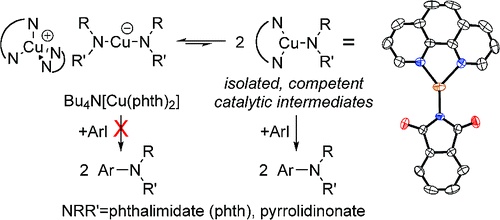Copper Complexes of Anionic Nitrogen Ligands in the Amidation and Imidation of Aryl Halides.

Copper(I) imidate and amidate complexes of chelating N,N-donor ligands, which are proposed intermediates in copper-catalyzed amidations of aryl halides, have been synthesized and characterized by X-ray diffraction and detailed solution-phase methods. In some cases, the complexes adopt neutral, three-coordinate trigonal planar structures in the solid state, but in other cases they adopt an ionic form consisting of an L2Cu+ cation and a CuX2− anion. A tetraalkylammonium salt of the CuX2− anion in which X = phthalimidate was also isolated. Conductivity measurements and 1H NMR spectra of mixtures of two complexes all indicate that the complexes exist predominantly in the ionic form in DMSO and DMF solutions. One complex was sufficiently soluble for conductance measurements in less polar solvents and was shown to adopt some degree of the ionic form in THF and predominantly the neutral form in benzene. The complexes containing dative nitrogen ligands reacted with iodoarenes and bromoarenes to form products from C−N coupling, but the ammonium salt of [Cu(phth)2]− did not. Similar selectivities for stoichiometric and catalytic reactions with two different iodoarenes and faster rates for the stoichiometric reactions implied that the isolated amidate and imidate complexes are intermediates in the reactions of amides and imides with haloarenes catalyzed by copper complexes containing dative N,N ligands. These amidates and imidates reacted much more slowly with chloroarenes, including chloroarenes that possess more favorable reduction potentials than some bromoarenes and that are known to undergo fast dissociation of chloride from the chloroarene radical anion. The reaction of o-(allyloxy)iodobenzene with [(phen)2Cu][Cu(pyrr)2] results in formation of the C−N coupled product in high yield and no detectable amount of the 3-methyl-2,3-dihydrobenzofuran or 3-methylene-2,3-dihydrobenzofuran products that would be expected from a reaction that generated free radicals. These data and computed reaction barriers argue against mechanisms in which the haloarene reacts with a two-coordinate anionic copper species and mechanisms that start with electron transfer to generate a free iodoarene radical anion. Instead, these data are more consistent with mechanisms involving cleavage of the carbon−halogen bond within the coordination sphere of the metal.
Read more on publisher's site.